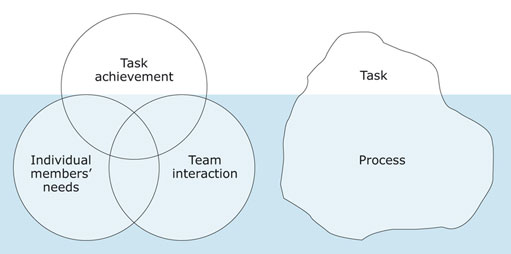5.8 Some tips on leading and managing teams
Team leaders and managers need to make sure the task is done and that the team develops in ways that benefit both the task and the experience of individual team members. Figure 3 illustrates how the task, the team and the individual are always linked. For example, team members’ satisfaction will be derived not only from the achievement of tasks but also from the quality of team relationships, team morale, trust and team spirit, and the more social aspects of teamwork.
Different leaders will inevitably have different styles and approaches to leadership. Some leaders may tend towards a more directive style, wanting to tell team members what to do. The danger here is alienating the team and not allowing room for creativity and spontaneity. The challenge for a leader who adopts this style will be to try to involve team members more and to seek their opinions. Other leaders may adopt a democratic approach, asking questions and getting people involved. The danger here is that debate drifts too much and no clear direction emerges. The challenge is to develop structure. Leaders may also differ in their degree of involvement in the task. However, successful and effective team leaders have some common characteristics. These include:
- listening to team members
- questioning them to understand their point of view
- being responsive to feedback.
Similarly, there are reasons why team leaders fail (Hackman, 1990, 2002). These are set out as reason and remedies in Box 7 with additional contributions by West (2004). Because of the overlap between leadership and management, some remedies cover management issues.
Box 7 Why team leaders fail: reasons and remedies
Reason: Calling the performing unit a team, but really managing them as individuals.
Remedy
- Assign individual responsibilities but coordinate them so that the efforts of individuals combine to form the whole-team product
- Alternatively, assign a team task and give members responsibility for determining how that task should be completed.
Reason: Exercising too little or too much authority: a typical mistake is giving a team too much autonomy early in its life when direction is needed and then intervening too heavily later when the team is not performing well.
Remedy
- Work closely with the team at the outset
- Draw up ground rules, including the amount and timing of management intervention
- Agree on a regular review process.
Reason: Assembling a large group in which structures and responsibilities are not clear.
Remedy
- Make sure that a well-designed team task is in place, that the team is balanced and suitable for the task and that members have clear and unambiguous information about the extent and limits of their authority and accountability. Team members will then not do things that are not required or make decisions that are not appropriate for them to make.
Reason: Specifying challenging team objectives but providing too little organisational support.
Remedy
- Ensure that resources and support are available
- Hold regular team reviews
- Ensure provision of individual training and development.
Reason: Assuming incorrectly that members already have the skills to work well as a team.
Remedy
- Conduct a team skills audit early in the team process: this can be a simple identification and review of members’ skills
- Address any training and development needs that emerge from this
- Encourage open discussion about individual strengths and weaknesses and team roles.

